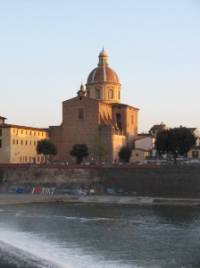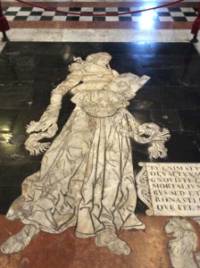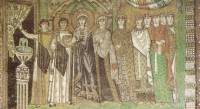
Italy
Italy is, during the 12th century, a patchwork of regions, independent kingdoms, lingering bits of the Holy Roman Empire, and city-states such as Venice.
For the purpose of Misrule, northern-to-central Italy (wildest Piedmont, bits of Lombardy, Emilia-Romagna, Tuscany) is the region of Etruria. The wild places heavily outnumber the tame.
Politics
Politics are many and varied. Generally, however, Etruria and its constituents have little desire to be part of the Holy Roman Empire, which seems only to pay lip-service to the Roman aspect of it and to be bound up in German/central European politics, and even less desire to be beholden to Rome and the Papal States, or to the kingdom of Sicily. Independence and self-dependence are where it's at, and in fact in many of the larger cities of the region (Milan and Firenze, notably) citizens have lobbied for, and received, many more civic rights and responsibilities than are evident elsewhere in Europe. Some of these results are because rulers have been so many flashes in the pan, lacking the charisma and intelligence of the French and English dynasties. Said rulers have been too busy maintaining a puissant face and trying not to be deposed to run the great cities, and have happily delegated to guilds and city citizens in exchange for token homage and some taxes.
Some are because of the singular and signal split between civilisation and the wild places in the region. Rome is all about being bound by ritual and the Church in the name of divine power and the saving of souls; the wild places of Etruria are happy to let these all quietly slide by.
History
Of most note is the recent victory of Milan over Barbarossa.
Society
Commerce
Etruria's few major cities are powerhouses in the region, but no match for the economic might of Venice. That said, they actively encourage the creation and furthering of guilds (Venetian and otherwise) within their borders.
Florence (Firenze) is the largest city. It's known for its tanners (who inhabit the Ponte Vecchio and surrounding area) and its goldworkers above all else. Because of the tanning and leather industry, the Arno is not the most sweet-smelling river.
Milan is finding its feet as well as its independence, valuating the different economic models on offer. It's in a bit of a rush though, because the Holy Roman Emperor is not best pleased with it.
Siena (and as far as it can reach into Umbria, which varies monthly) has a thriving trade in pigments, especially earth tones.
Culture
Etruria is inconsistent. From the commercial focus of Florence to the more unearthly one of Siena; from the strega of the mountains and other wild places to those who hark back to a “purer” (read more pagan) Roman influence—no one region or city succeeds in establishing itself as the defining character or characteristic.
Etruria is a place where the late sun is the same colour as the earth. Where the cypresses cut their green swathes into the evening light. Where wine is not just a trade but a way of life.
And yet, Etruria is also the dark caverns of the alps, the deep reaches of the Lakes; where the Church exists, yes, but alongside beliefs which have evolved (devolved?) from the Latinate heyday of yesteryear.
Tales of Place, of Folk and Fey
Florence (Firenze)
 Florence may well be a model of civilisation and trade, but there are dark roots. Father Arno is the deity who controls the River Arno. The River Arno flows straight through the heart of Firenze.It expands into the swamps that surround the city, and runs under its great bridges. Not much mentioned nowadays by the young, certain ancient craftsmen in Firenze swear that Father Arno helps them in their endeavours, especially metalworking, and especially goldwork. Those who please him will find demand for their services high; those who sell their knowledge cheaply or unwisely are found floating face-down, or worse.
Florence may well be a model of civilisation and trade, but there are dark roots. Father Arno is the deity who controls the River Arno. The River Arno flows straight through the heart of Firenze.It expands into the swamps that surround the city, and runs under its great bridges. Not much mentioned nowadays by the young, certain ancient craftsmen in Firenze swear that Father Arno helps them in their endeavours, especially metalworking, and especially goldwork. Those who please him will find demand for their services high; those who sell their knowledge cheaply or unwisely are found floating face-down, or worse.
Health can be precarious in Firenze due to outbreaks of swamp fever.
Siena
Siena is the strongest hold the Church has in the region. It has a wondrous cathedral with renowned frescoes. It is situated on hilltops, which make it defensible. It gives its name to the pigment it is most known for. There is no obvious fey presence in the city.
Milan
Milan quite fancies itself as a military power–or at least, Agostina Desiderati, who recently led the Milanese forces, fancies herself a military leader. In concert with her advisers, she is looking at hiring Milanese might to Venetian merchants, and not considering eventual conquest at all.
The Po river has been silent for a century. Clearly the Holy Roman Empire beat down any local cults.
Ravenna
Both the Pope and the Eastern Church still hold some sway here. It is rightly ignored, if not shunned, by anyone who wants to live their own life and not be sucked into the churches' games of power politicking.
The Wilds
Outside the cities and the fortified places are the wilds. These encroach on the edges of the ostensibly-tamed vineyards, run deep in the lakes, and walk the mountains. Many and various names are given to the Old Ways here, and many and different practices are carried out. It is fortunate then that due to the fractured and fractious nature of the region, they've never yet bothered to rise up against anybody except the occasional willful (or hapless) preacher or trespasser.
Notable Wilds Personae: the Strega
The strega are called witches by the civilised. They practice magics which they claim were given to them by the Queen of the Fairies, whom they name Diana. They live in isolated regions of any geography, meeting only in a Grand Conclave, the timing of which is uncertain. Some live the life of huntresses in the woods; some, more eremetic, become oreadic wise folk; some are said to live under the lakes in palaces so extravagant the tales of them have made it (in changed form) all the way to the French king's stronghold.
Notable Wilds Myth: the Sibyls
 The Sibyls grant wisdom and oracular knowledge. Some say they are psychopomps, that they ease the transition into death. Others say they hire themselves out as professional muses and tutors in arts unseen since the days of Marcus Aurelius. Whatever they actually are is mostly irrelevant, since no one has found one in centuries, despite the legends persisting.
The Sibyls grant wisdom and oracular knowledge. Some say they are psychopomps, that they ease the transition into death. Others say they hire themselves out as professional muses and tutors in arts unseen since the days of Marcus Aurelius. Whatever they actually are is mostly irrelevant, since no one has found one in centuries, despite the legends persisting.

